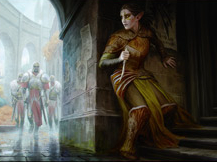Commander Builds: Telegraphing vs Concealing
When you select your commander, one of two things are going to be true if you are playing in a pod with some moderately experienced commander players. Either your opponents are going to know what your commander does and will have an understanding of the strategy, or they will have to go in blind. Either way is fine, but I have found that some players aren’t playing with them correctly. So this week I would like to discuss the difference between a telegraphed commander and a concealed commander.
As stated before, a telegraphed commander is a commander that has a very obvious strategy out the gate that is known from the table. Examples of this would be Uril, the Miststalker, Kyler Sigardian Emissary, and Narset Enlightened Master. When your opponent sees the commander hit the table, it usually draws some attention and your opponent knows what to expect. With that being said, there are some advantages to this.
The perk of having a telegraphed commander is you are going to have a high powered card in your opening hand every single game in your commander. This cannot be overlooked as having a primary game plan always available to you can be very helpful as you set up your board in the first few turns. This plan also allows you to focus hard on your strategy as it is already transparent what your strategy is. In addition, if you know the players you are playing well enough, you can look into adding cards into your deck that counter your opponent’s attempts to throw you off of your game.
You opponents have intel on you. If your deck has well known value pieces or win conditions, your opponents have the opportunity to hold up interaction to deal with those pieces as they come along. This type of strategy also eliminates the element of surprise from your deck as most of the plays will be in support of your main plan which is known.
Handling a telegraphed commander deck is kind of like being the 2023 Philadelphia Eagles. Everyone in the stadium knows the QB sneak is coming, but good luck stopping it. You may need to have more defensive spells in your deck if that telegraphed commander is going to come off as a threat. Ultimately, but having a more focused card in the command zone, you don’t have the element of surprise, but you have a more established game plan. As far an deck construction goes, redundancy will be key. You will want to have as many cards that work toward your end goal as possible. If your deck is a landfall deck, loan up on landfall cards, if its a voltron deck, work on getting you commander out as quickly as possible.
A concealing deck is a deck that wants to hide its strategy for as long as possible, or is so versatile that the strategy is indecipherable at the start of the game. An example of this might be something along the lines of a hidden commander with Prismatic Bridge or something extremely versatile in the realm of Kenrith or Atraxa. The main benefit of a deck like this is in your element of surprise. The shelf life of a surprise like this is usually 1-2 games, so enjoy it! By playing with a hidden strategy, it can be more difficult for your opponents to know how much of a threat you are or how concerning certain cards might be for them in your plan which can lead to wins or strong positions out of seemingly nowhere.
Where a deck that has a strength in hiding its plans is strong, it may lose tempo, time, or efficiency when you are in the game itself. By not having your strategy in the command zone with a card you can cast and recast, you are setting yourself up to have a situation where you will be at the mercy of your draws. Another thing working against you is the fear of the unknown. Certain players in EDH will see the devil you know as less threatening than the unknown and hard target you until they can decipher what your strategy is which can cause you to have to play from behind.
With this type of deck you're going to want to hold cards back and sandbag you play for a while. It is essential to pick your moment to reveal what you are trying to do. I always wait for someone to play some scary things to the board to attract excess attention to what you are trying to do so removal goes that direction initially, keeping you and your things around for longer. To best hide your intentions for longer, staples and generic value cards are going to be your friend. They will gain you value without the risk of giving up your main strategy, keeping you in the game.
Neither option between concealing and telegraphing is the wrong way to go about things as the commander you want to build doesn’t always give you a choice. At the end of the day, commander is about having fun and you should play what you like!
Thanks for Reading! If you have a topic you would like to see covered on The Thought Vessel Blog or the Thought Vessel Show, send us an email at thoughtvesselshow@gmail.com


Comments
Post a Comment